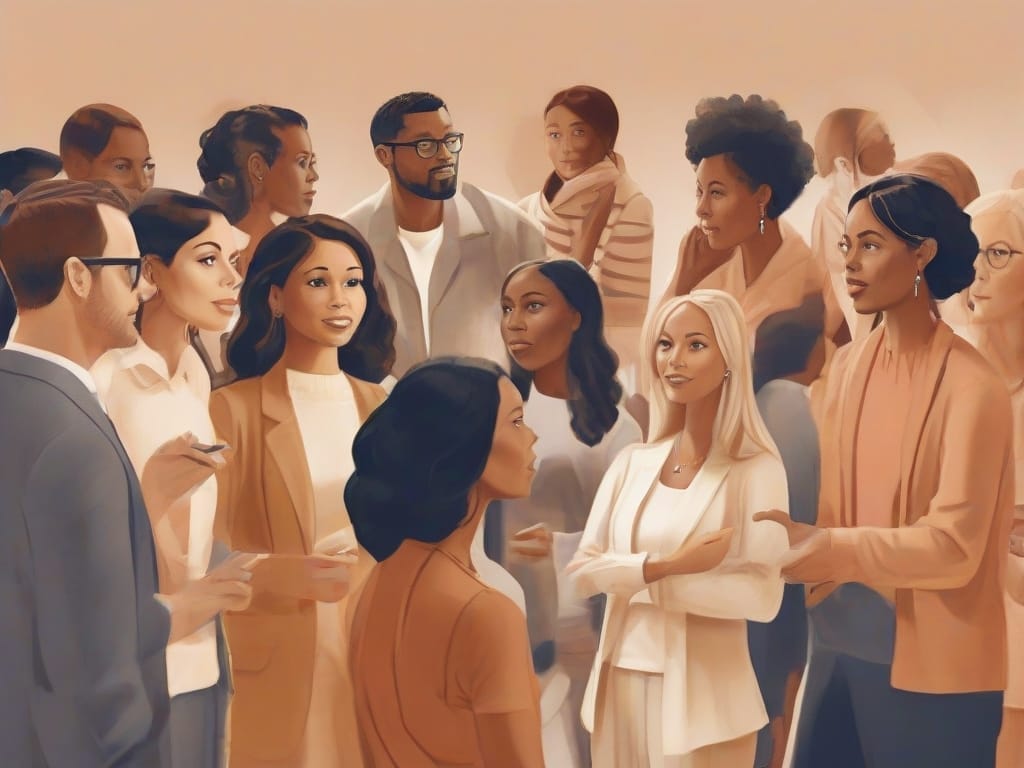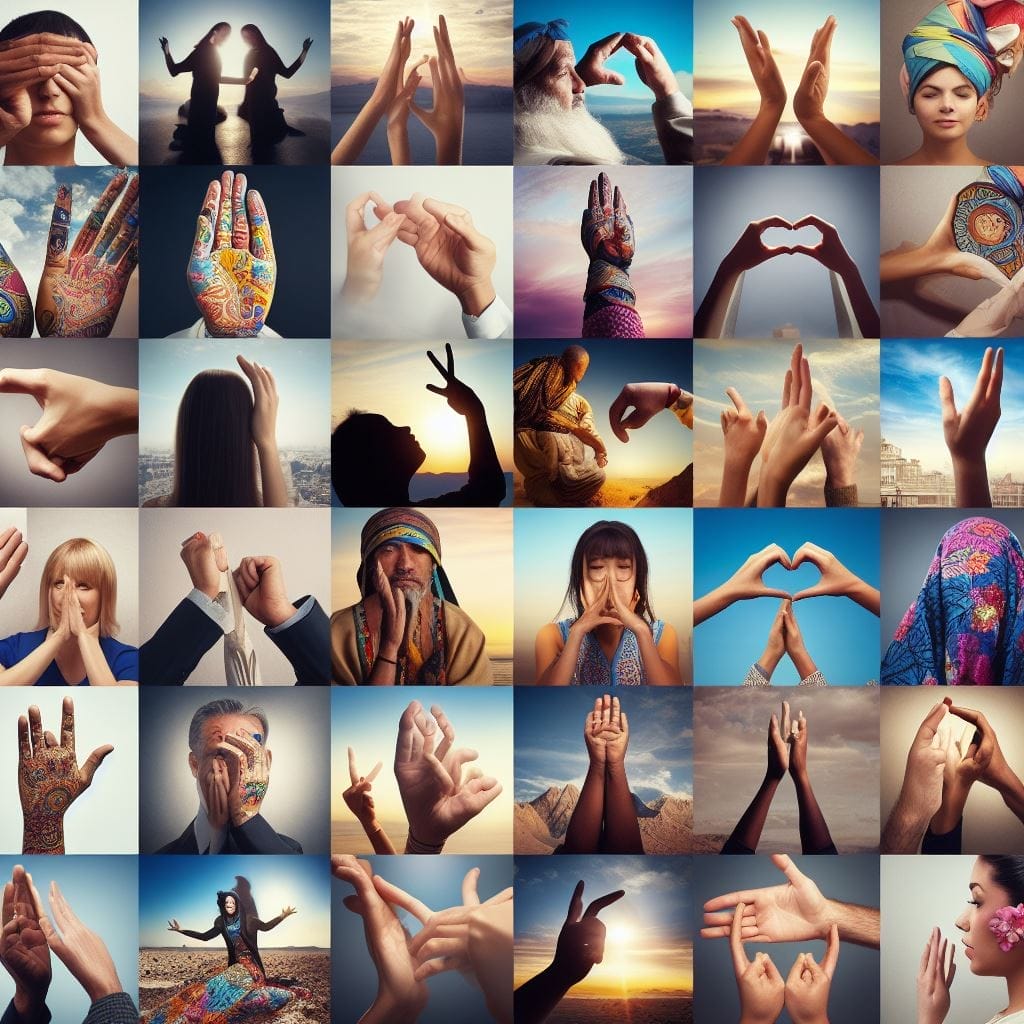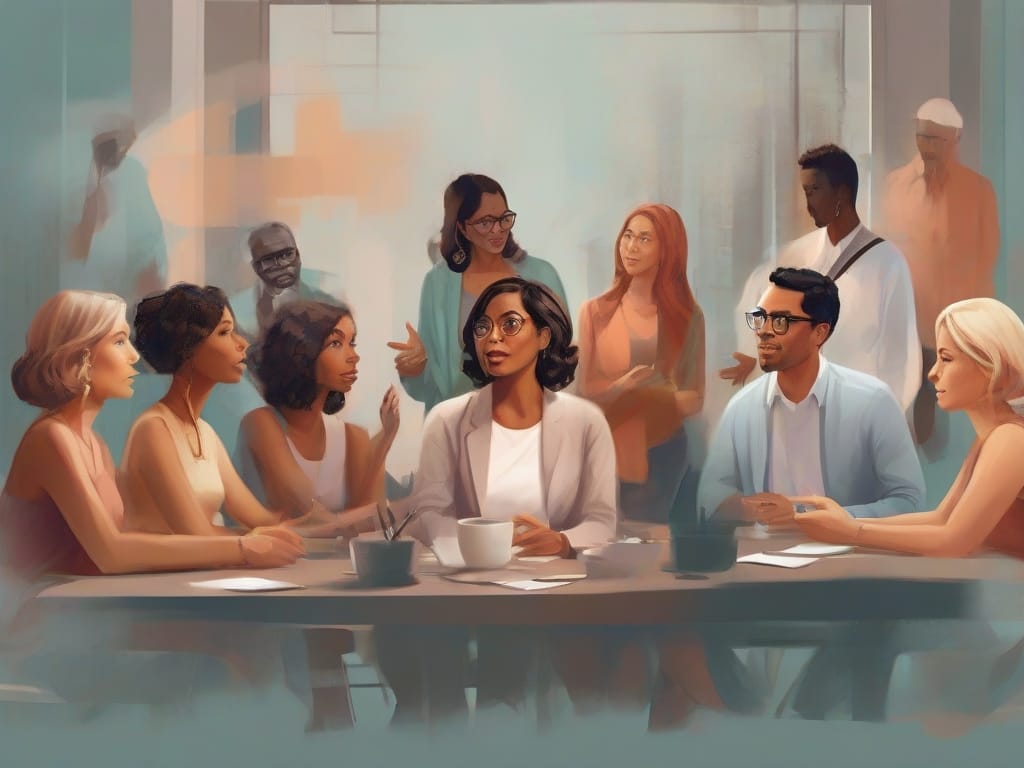Introduction
In our world, communication goes beyond words. We’re fascinated by body movements, facial expressions, and gestures. The enigma lies in deciphering this intricate code—can body language be accurately interpreted? Come on a journey to learn about nonverbal communication. We’ll explore facial expressions, gestures, and postures that convey hidden messages.
Body language, which is a way to express ourselves, goes beyond using words. It includes the small movements of the face, the powerful movements of the body, and the unspoken language of how we hold ourselves. Body language is a mix of art and science that invites us to explore its mysteries.
In this exploration, we will dissect the controversy surrounding accurate body language interpretation. The main point here is to understand both the body language shown and its meaning. As we look at different meanings, we’ll learn about nonverbal cues and what affects their accuracy.
Come with me to see how different cultures and contexts affect how we use body language. We’ll look at how body language changes in different situations and cultures, with real-life examples.
So, can body language truly be accurately interpreted? By exploring science, culture, and emotions, we can understand the complexities of this question. Get ready to see the little signs, understand hidden messages, and discover body language and facial expressions.
Key Takeaways:
After navigating the rich tapestry of “Can Body Language Truly Be Accurately Interpreted?” Here’s a guide that reveals the hidden meaning of nonverbal communication.
1. Discover the meaning and significance of body language, which goes beyond words to express feelings and thoughts.
2. Explore the origins of body language interpretation. Learn how studies and research prove nonverbal cues can be decoded accurately.
3. Explore how cultural norms affect the interpretation of body language. Learn how body language changes in different settings through case studies.
4. Learn about nonverbal cues that are universally recognized and understood across cultures. See examples of successful interpretations through real-life illustrations of body language.
5. Learn how body language can be misinterpreted, what impacts accuracy, and strategies to improve interpretation.
6. Learn how feelings affect nonverbal cues, recognize common emotional displays in body language, and get recommendations for interpreting emotions as they should be.
7. Challenge false ideas about reading body language by using multiple cues for accuracy.
8. Learn how to use body language in everyday life to improve communication skills and understand others. Understanding nonverbal cues can greatly impact personal and professional situations.
Start this enlightening journey to learn about body language and facial expressions. Improve your understanding of nonverbal communication in everyday interactions by decoding unspoken messages. Embrace its power.

The Scientific Foundation of Body Language Interpretation
Exploration of the Origins
To understand body language, we must first explore where it comes from. How did this silent form of communication evolve? To understand its significance today, we need to know the history behind it.
Decoding Nonverbal Cues: Studies and Research
Scientific validation forms the backbone of our exploration. Studies and research supporting the accuracy of decoding nonverbal cues provide compelling evidence. Explore the proof that helps the idea that frame language is its language.
Important Elements Affecting the Interpretation of Body Language
Understanding frame language is a nuanced art, with different factors influencing its interpretation. Let’s delve into these key elements:
1. Facial Expressions
- Definition: Movements of the face conveying emotions.
- Examples include eyebrow raises, frowns, and smiles.
- Impact: Significant in gauging feelings and intentions.
2. Gestures and Movements
- Definition: Actions and motions of the body.
- Examples: Handshakes, nods, posture changes.
- Impact: Reflects attitudes, engagement, and receptiveness.
3. Eye Contact
- Definition: The act of looking directly into someone’s eyes.
- Examples: Sustained stare, avoidance of eye contact.
- Impact: Signals confidence, honesty, and interest.
4. Posture
- Definition: The position of the body while sitting, standing, or moving.
- Examples: Slouching, upright stance, crossed arms.
- Impact: Conveys openness, authority, or defensiveness.
5. Proximity
- Definition: The physical distance between individuals during interaction.
- Examples: Personal space, invading personal space.
- Impact: Denotes closeness, ease, or discomfort.
6. Touch
- Definition: Physical contact, such as handshakes or hugs.
- Examples: Firm handshake, pat on the back.
- Impact: Varies culturally; can signify warmth, aggression, or support.
7. Voice Tone and Pitch
- Definition: Quality and pitch of vocal expression.
- Examples: High-pitched, monotone, enthusiastic.
- Impact: Affects the emotional tone of communication.
8. Microexpressions
- Definition: Fleeting facial expressions lasting a fraction of a second.
- Examples: Quick smirk, subtle eyebrow raise.
- Impact: Unconscious signals reveal true emotions.
9. Consistency with Verbal Communication
- Definition: Alignment of body language with spoken words.
- Examples: Nodding in agreement, mismatch between words and gestures.
- Impact: Builds trust when verbal and nonverbal cues align.
10. Cultural Variations
- Definition: Differences in body language interpretation across cultures.
- Examples: Bowing in Asian cultures, hand gestures in different regions.
- Impact: Awareness is crucial to avoid misinterpretation.
Understanding Cultural and Contextual Variations
A. The Impact of Cultural Norms on Body Language Interpretation
Body language analysis is a crucial part of human communication. It facilitates us to recognize each other better. Body language could be very vital. It can say a lot without using words.
Importance of Body Language
It is important to understand body language because it is more than gestures. Being able to understand body language helps us see people’s true feelings, even without words.
Reading Body Language in Different Contexts
The context wherein frame language is interpreted performs a sizeable role. The way you maintain your frame, your facial expressions, and how you circulate can imply different things depending on the state of affairs or tradition. Studying body language is an art. It needs a sharp eye for detail and cultural understanding.
B. Interpreting Body Language in Different Settings
Cultural and Contextual Variations
In diverse settings, interpreting body language takes on a dynamic form. Studies have proven that facial expressions, gestures, and use of space can vary across cultures. It’s essential to realize that gestures can mean various things in special cultures.
A former FBI agent, who’s informed about nonverbal communication, says this.
The Role of Body Language in Human Interactions
When people interact, body language is important for making a good first impression. In various situations, such as a work meeting, a party, or meeting people from different cultures, the way someone crosses their arms or avoids eye contact can say a lot.
Judges and jurors rely on body language analysis to understand nervousness and anxiety. This helps them gain insights that verbal communication may not convey.
C. Case Studies Highlighting Cultural and Contextual Variations
Navigating Nonverbal Forms of Communication
Studies have found that body language can show emotions through the eyes and face. Learning to read and recognize these particular facial expressions and hand gestures can provide a better understanding of the emotional body language of others.
Building Trust Through Body Language
One charming factor is how body language can assist in building consider without pronouncing a phrase. Eye touch, frame language, and gestures all play a part in nonverbal verbal exchange.

Universal Nonverbal Cues and Their Interpretation
A. Examining Universally Recognized Nonverbal Signals
In our diverse world, body language is a universal way to communicate without words. Let’s explore the details of nonverbal signals and understand the hidden messages they convey.
Unveiling the Silent Vocabulary
When it comes to nonverbal communication, our bodies express a lot through gestures. Each gesture tells a story. Decoding this secret language is like reading an old text, where every motion has a tale.
The Eyes: Windows to the Soul
Begin this journey by exploring the eloquence of the eyes and eyebrows. These small gestures express feelings in a way that words often can’t quite capture. As you engage in conversation, observe the flicker of the eyes—quick and fleeting, yet laden with meaning. It’s the dance of unspoken thoughts, a ballet of emotions that speak volumes.
Facial and Hand Gestures: The Artistry of Expression
Move beyond the eyes, and you’ll find the canvas of expression expanding to the face and hands. Facial and hand gestures are the brushstrokes that paint the emotional landscape. Simple actions like raising an eyebrow or gesturing with your hand can make spoken words more powerful.
B. Decoding Nonverbal Cues Across Cultures
Bridging Cultural Divides
Learning about nonverbal cues reveals that gestures can go beyond cultures and are very interesting. Smiling, nodding, or shaking hands creates a universal language that goes beyond words. But beware, for interpretations can vary. What may be a sign of agreement in one culture might convey hesitation in another.
Cultural Sensitivity: The Key to Effective Communication
Successful interpretation across cultures requires finesse and cultural sensitivity. Understanding and respecting diverse interpretations of body language creates meaningful connections. It’s like a sensitive dance. This talent is essential in an increasingly interconnected global community.
C. Real-life illustrations of Universally Understood Body Language
From Boardrooms to Living Rooms
Let’s bring theory to life with real-world examples of universally understood body language. Imagine a firm handshake sealing a business deal, a nod showing agreement in a meeting, or a reassuring pat on the back saying a lot without words.
The Dance of Nonverbal Symphonies
Body language is not confined to formal settings. It permeates our daily interactions, influencing how we connect on a personal level. A hug and a pat on the shoulder make bonds that words cannot create.
Decoding the Challenges and Strategies for Precision
Hey there, savvy readers! Have you ever been confused by someone’s body language? Fear not! In this article, we will explore body language interpretation. We will discuss its limits, things that affect accuracy, and ways to improve decoding skills.
Instances where body language misinterpretation can occur
Navigating the realm of nonverbal cues can be like traversing a linguistic maze. Let’s uncover the scenarios where decoding body language might take you down the wrong path:
- Sometimes, the face and body don’t match, which can make it hard to understand each other.
- Cultural differences can cause misunderstandings when body language is misinterpreted.
- To analyze body language, pay attention to small gestures that are often missed in fast conversations.
Factors that can affect the accuracy of body language decoding
Recognizing the obstacles is the first step toward conquering them. There are matters which can make it tougher to interpret body language appropriately.
- When verbal and nonverbal cues mix, it could be hard to recognize each other.
- Since everyone is unique, it’s crucial to be aware of their body language.
- Environmental factors can impact the accuracy of reading nonverbal signals.
Strategies to mitigate the challenges and improve interpretation
Now, let’s equip you with the tools to navigate the labyrinth of body language with finesse. Here are strategies to enhance your decoding skills:
- Conscious Observation: Regularly practice analyzing body language to improve your observational skills.
- Educate Yourself: Learn to recognize the different types of body language and their cultural nuances.
- Build Trust Through Signals: Utilize body language cues to convey information and establish trust in both personal and professional settings.
Emotions’ Significance in Body Language Interpretation
To understand how emotions affect body language, we want to realize how they influence nonverbal cues. It’s no longer pretty much what is said however the way it’s conveyed through the subtle dance of frame gestures and expressions.
II. The Dance of Emotions in Body Language
A. Emotions as Conductors
Emotions, just like conductors, orchestrate the nonverbal performance. Learn the way to examine body language to apprehend human beings’s emotions without them speaking.
1. Joyful Symphony
A smiling face, an open posture—these are notes in the symphony of joy. Discover the meaning of these signals and learn how the body expresses joy.
2. The Melancholy Waltz
Drooping shoulders, a furrowed brow—the dance of sadness. Explore the subtleties of sad faces and understand the unspoken messages they convey.
3. The Tango of Anger
Clenched fists, a piercing gaze—the tango of anger is intense. Discover how anger shows in the body and learn how to interpret this intense emotion.
B. Practical Tips for the Body Language Maestro
1. Attune Your Senses
Developing a higher understanding of body language calls for a keen statement. Train your senses to pick up on subtle cues that might escape the untrained eye.
2. Decode the Unspoken
Just as a 2d language requires interpreting, so does frame language. Learn the artwork of decoding nonverbal alerts to beautify your conversation capabilities.
3. Using Body Language to Establish Trust
Trust is the cornerstone of a powerful communique. Discover the strength of body language to construct agree with and stronger connections in your existence.

Myths and Misconceptions Regarding Body Language
A. Dispelling Common Myths About Interpreting Body Language
People often misinterpret the complex art of body language in human interaction. Let’s delve into the common fallacies surrounding the interpretation of nonverbal cues.
Myth 1: There Is a Universal Language Spoken by Body Language
Many humans assume interpreting nonverbal cues is the same for anybody, however it’s not. Everyone’s body language is special, laid low with the subculture, non-public traits, and the scenario. What may signal confidence in one culture might convey discomfort in another.
Myth 2: Matching Body Language Guarantees Trust
Mirroring someone’s movements is said to build trust, but it’s important to be genuine. Copying someone’s gestures without thinking can make you seem fake and harm trust.
Myth 3: Body Language Signals Are Always Intentional
Not every gesture or expression is a deliberate form of communication. People unknowingly show nonverbal cues, so it’s essential to reflect on consideration of the entire situation earlier than figuring it out. Misinterpreting accidental cues can result in misunderstandings.
B. Frequently Held Myths That Impair Your Ability to Interpret Nonverbal Cues Accurately
Misconception 1: Face and the Body Always Align in Message Conveyance
It’s a misconception that facial expressions and body movements consistently align. People can have a neutral face but show different body language, and vice versa. Relying solely on one thing can bring about an incomplete interpretation.
Misconception 2: Nonverbal Communication Is More Trustworthy Than Spoken Words
While nonverbal communique is undeniably good sized, it needs to not overshadow verbal language. Both forms of communication support each other. To fully understand, we need to consider spoken and unspoken messages. The interplay between spoken words and body language enhances comprehension.
Misconception 3: Language Can Be Used to Manipulate
Some misconstrue the power of body language as a tool for manipulation. While certain gestures and expressions can influence perception, authenticity cannot be masked. When human beings talk surely, their actual emotions and intentions will always come via.
C. Using a Variety of Cues to Interpret Information Accurately
The Various Aspects of Body Language
Understanding frame language requires acknowledging its multifaceted nature. How someone acts, their facial expressions and the way they stand are all a part of frame language. To understand the message, reflect on the consideration of how these types of elements paint together.
Utilizing Multiple Cues for Enhanced Accuracy
To improve knowledge of frame language, it’s vital to search for multiple cues right now. Observe a person’s face, hands, and body language to determine their emotions and implied meanings.
Nonverbal Communication’s Function in Establishing Trust
Recognizing the importance of nonverbal communique in fostering trust is paramount. Creating a bond through genuine body language helps build trust and credibility. Trust is fragile and depends on how people interact. Understanding body language can help build trust.
Practical Applications of Body Language Interpretation
Understanding frame language is like having a secret decoder for human interactions. In this phase, we can take a look at how frame language may be utilized in regular lifestyles and paintings. So, allow’s dive into the nuances of nonverbal verbal exchange.
A. How individuals can utilize body language interpretation in personal and professional life
1. Developing Nonverbal Communication to Build Trust
In both personal and expert relationships, agreeing is the cornerstone. By understanding body language, people can build trust by interpreting hidden signals. To build trust, have a firm handshake, look into their eyes, and use open gestures.
2. Navigating Social Situations with Ease
Picture yourself effortlessly navigating social events, understanding nonverbal cues, and adjusting your communication style. Understanding body language helps people navigate social situations easily and enjoyably.
3. Enhancing Leadership Skills
Leadership extends beyond words. Effective leaders display confidence, authority, and empathy through their body language. Leaders can create a positive work environment by understanding others’ body language.
B. Ways to improve one’s nonverbal communication skills
1. Self-cognizance: The Key to Improvement
Self-consciousness marks the start of the trip. To improve nonverbal communication, watch and think about how you use body language. Identifying areas for improvement helps you grow in specific ways. This leads to better and more meaningful communication.
2. Practice Makes Perfect
Just as with any skill, practice is essential. To improve, engage in role-playing, get feedback from trusted peers, and refine nonverbal cues. Like language, body language becomes more fluent with dedicated practice.
C. Cases where accurate body language interpretation has had significant outcomes
1. The Job Interview Game-Changer
Imagine excelling in a job interview by using more than just words. Show confidence through posture, genuine smiles, and attentive body language. Many candidates get jobs by reading and responding well to nonverbal cues.
2. Relationship Rescues Through Understanding
In personal relationships, the ability to interpret body language can be a lifeline. Couples can improve their relationships by understanding each other’s nonverbal signals. This helps them to feel empathy and build stronger connections.
3. Negotiation Triumphs
Understanding body language can give you an advantage in meetings and negotiations. Being able to notice small signs of agreement or disagreement helps in negotiations, making them more successful.

My Journey of Deciphering Nonverbal Cues: A Personal Odyssey
I’ve started to explore the complex world of nonverbal communication between people. I became interested in body language during an important moment in my career. Body language had a big impact.
I saw myself in a high-stakes business negotiation several years ago. A sense of delight filled the room. People spoke, but it was the unspoken cues that mattered. As I watched how people moved and reacted, I realized how much they were saying without words.
My coworker’s small nod showed agreement when it was important, without needing to talk. I had a moment of realization. The body’s language can be as powerful as words.
This experience made me want to learn and become an expert in body language. I learned about the science behind nonverbal cues through research and reading studies. On my trip, I noticed how cultures influence people’s physical expression in various ways.
One particular encounter in a cross-cultural business setting stands out. Understanding cultural and contextual variations in nonverbal communication is important. This includes hand gestures, eye contact norms, and personal space. They can vary subtly.
I watched people from different cultures and noticed how gestures can communicate without words. Certain expressions were understood by everyone, showing how we all have similar experiences.
However, my journey also made me realize the difficulties of understanding body language. Misinterpretation occurs when we fail to understand and consider various cues for accuracy.
As I think about this journey, I see how emotions greatly influence nonverbal cues. I learned how to interpret body language by understanding emotional displays. It was important for my exploration.
I learned to debunk myths and challenge misconceptions about decoding the body’s language. Understanding body language can be helpful in both personal and professional situations. This showed how it can transform interactions.
In conclusion, I learned a lot about nonverbal communication and it changed me. My ability to understand complex interactions has improved. I now appreciate the unspoken conversations that shape our connections. I keep exploring and inspiring others to explore this interesting area. It reminds me that our understanding of the body’s language is always changing.
FAQs: Can body language be accurately interpreted?
1. Can you explain the importance of body language in communication and how it helps build connections?
Decoding body language is like understanding a silent language beyond words. You can tell how a person feels and what they assume by way of how they appear and act. Research has proven that frame language is essential for making connections. Certain gestures and eye contact can build trust.
Our body language is important for connecting with others without using words. By observing how others use their body and face, we can understand their emotions and nonverbal communication. Everybody tells a story, and mastering the study of body language can greatly enhance one’s ability to connect with others.
2. Can you explore the different types of body language that affect our daily communication? A detailed body language analysis can reveal unspoken thoughts and emotions.
Exploring body language uncovers many nonverbal signals that affect daily communication. Every emotion shown in the eyes and gestures contributes to a complex grammar system. We can understand what someone is thinking and feeling by looking at their body language.
Body language comes in many forms, like sign language and specific gestures. Its impact is visible in the amount of eye contact during interactions. We exchange millions of views through body language, so understanding it helps in social situations.
3. How can people get better at reading body language and understanding interpersonal dynamics?
Learning to read body language and understand people’s behavior is like mastering a valuable skill. Analyzing how others move and act is important. It helps detect emotions and understand judgments. Everyone expresses emotions differently. Improving nonverbal communication skills helps in social interactions. Nonverbal cues, like smiles, hand movements, and eye contact, help create trust and comprehension.
Conclusion: Can body language be accurately interpreted?
As we wrap up our study on nonverbal communication, we see how body language and facial expressions connect without words. Here’s a brief recap in bullet points:
- We began by learning about body language, which is a complicated and universal way to communicate.
- We explored the scientific foundation. We studied research on the origin and accuracy of body language interpretation.
- We interpret body language differently in various settings due to cultural norms. Case studies illuminated the richness of these variations.
- Nonverbal cues are signals that everyone can understand, regardless of culture, and they show the power of a shared language.
- We acknowledged misinterpretation and confronted challenges, recognizing the need for a nuanced approach. We considered multiple cues for accuracy.
- Emotions can silently influence nonverbal cues like conductors guiding their ebb and flow. Practical tips provided insights into accurately interpreting the language of emotions.
- We debunked myths and embraced practicality. We saw how interpreting body language accurately can change outcomes.
A Call to Continue the Exploration
As we finish this journey, remember that the body’s language is always changing. Our understanding only scratches the surface. To continue your exploration and master the art of decoding nonverbal cues:
👉 Practice the Art: Observe and interpret body language in various situations to hone your skills.
Learn about different cultures to better understand how contexts can vary across cultures.
Stay curious and embrace the ever-changing nature of nonverbal communication. Be curious about the unspoken conversations that shape human connections.
In the grand symphony of human interaction, decoding the language of the body adds a harmonious layer. May your exploration of nonverbal communication be enlightening and transformative. Keep deciphering, keep connecting.

Sarah Andrews’ work on relationships is informed by a breadth of experience and a strong interest in human nature. Sarah, who holds a Psychology degree and has a good eye for nuances, delves into the complexity of communication and emotion, delivering insightful insights for readers seeking personal growth and emotional pleasure. Sarah hopes that her empathic approach and insightful suggestions will motivate readers to understand themselves and their relationships better.
